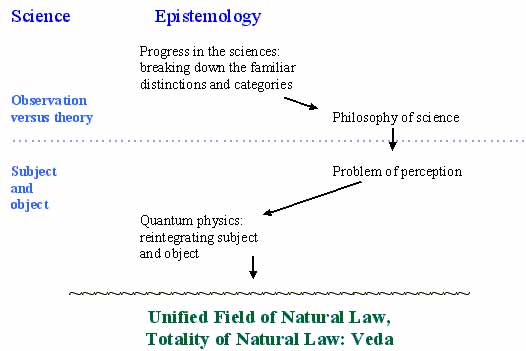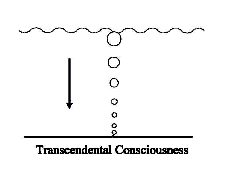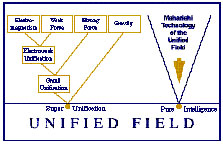Maharishi Vedic Science and Technology
Maharishi Vedic Science and TechnologySM:
The Solution to Fundamental Epistemological Issues at the Basis of Modern Scientific Thought
by David Scharf, PhD
Maharishi Mahesh Yogi, regarded by many as jagadguru because of the scale of his accomplishments, is nowadays occupied in a race against time to forestall the spread of global terrorism-and the destructive response it provokes-by means of his Vedic technologies for world peace. Hence it might seem a luxury to take time out for scholarly pursuits. On the contrary, it is more than ever necessary to demonstrate the validity and importance of the Vedic knowledge and the traditional technologies based on this knowledge, not only for individual evolution, health and enlightenment, but also for the enhancement of collective consciousness and the reduction of societal stress-in order to make world peace a real possibility.
Part One. Maharishi’s Vedic Science and Technology: Higher states of consciousness and the Consciousness-basedSM understanding of reality
The individual is cosmic.
Maharishi is widely known for his practical programs: the Transcendental Meditation® program introduced in the 1950s and the TM-Sidhi® program including Yogic Flying, Maharishi Ayur-vedaSM, Maharishi Vedic Vibration TechnologySM, Maharishi Sthapatya VedaSM, Maharishi Vedic Organic AgricultureSM and the Global Country of World Peace. But Maharishi has also established a series of academic universities around the world in order to preserve the traditional Vedic knowledge and to effectively integrate this knowledge with modern science and learning. Maharishi has worked for decades on the fundamental scholarship needed for resolving the deepest issues in every theoretical discipline in Vedic terms – on the basis of the priority of consciousness.
The fundamental Vedic truth is that the individual is cosmic. Aham Brahmasmi, “I am the Totality,” expresses the principle that consciousness-rather than being a relatively unimportant derivative of brain neurochemistry as it is regarded, for example, by materialistic scientists-is actually the basis of the whole universe. Maharishi’s Vedic conception and demonstration of consciousness presents consciousness as both:
- the foundation of individual subjective experience, and
- the fundamental field at the basis of objective reality.
The Transcendental Meditation program.
More than five million people around the world have learned the Transcendental Meditation technique-a simple, natural, mental technique practiced for 15 to 20 minutes morning and evening. During the Transcendental Meditation technique, one’s awareness settles down and one experiences a unique state of restful alertness, Transcendental Consciousness (see Figure 1). This is the simplest form of awareness, consciousness by itself-with no object-and it contains the full creative potential of the mind.
|
Measurable correlates and outcomes of the Transcendental Meditation procedure are widely documented by over 600 studies at more than 200 universities and research institutions in 30 countries and range from increased blood flow to the brain, unique patterns of EEG coherence and decreased plasma cortisol during the practice to numerous benefits in daily life, such as improved cardiovascular function, faster reaction time, increased IQ and creativity and greater self-actualization.
Transcendental Consciousness – samadhi – is distinguished clinically from ordinary waking, dreaming and sleep both by its unique subjective experience and its very distinctive and characteristic set of physiological parameters, clearly demarking it as a 4th major state of consciousness which should not be confused with any sort of altered value of waking state. |
Cosmic Consciousness.
With long-term practice of Transcendental Meditation, the experience of pure consciousness comes to be stabilized outside of meditation, even in deep sleep. This phenomenon of sustained awareness during sleep is called “witnessing”. Maharishi describes this state of moksha or liberation as “Cosmic Consciousness,” and it is characterized by the permanence of Yoga: As the Bhagavad Gita advises, “Yogasthah kuru karmani,” Established in Yoga, perform action (Bhagavad Gita, 2.48). People experiencing Cosmic Consciousness show distinctive EEG patterns during activity that suggest the maintenance of transcendence along with waking processes. According to new research by psychologist Fred Travis, at the Maharishi University of Management, in Fairfield, Iowa, people experiencing Cosmic Consciousness have more precise and accurate thought processes when faced with complex tasks. Their brains exert task-oriented activity only at the appropriate time, not unnecessarily wasting energy anticipating the task. Moreover, those in the Cosmic Consciousness group reported witnessing during sleep for at least a year – and in some cases for as long as 12 years. Professor Travis is developing an “integration scale” that correlates increased experiences of transcendence with increasing EEG coherence during waking and with a more efficient and appropriate response to tasks.
Cosmic Consciousness is the first stage of enlightenment; although Transcendental Consciousness has become stabilized in daily life, there is a persistent experience of duality in which the knower experiences himself or herself as separate from the experienced world. The highest stage of enlightenment is Brahmi Chetena, or Unity Consciousness, in which all things are perceived as expressions of the Self. This is not merely an intellectual understanding, it is a state of consciousness based on a refined style of functioning of the nervous system.
The Samhita of Rishi, Devata and Chhandas.
In the terms of Maharishi’s Vedic Science, the transcendental, unified field of life (see Figure 1 below) is called Samhita. The division of subject and object comes when the unexpressed totality, Samhita, becomes aware of itself creating an apparent break of the
|
unbreakable, giving rise to the Knower (the subject or observer) referred to by Maharishi as Rishi, the object of knowing, which he calls Chhandas and the connection between the two, the process of knowing or Devata. Transcendental Consciousness, experienced during the practice of Transcendental Meditation, reverses this separation and restores the transcendental unity of subject and object. With the practice of TM, one transcends the realm of diversity to experience Samhita, the unified value of consciousness. In Unity Consciousness, the whole world is experienced in terms of this Samhita, or Wholeness. |
Maharishi’s Vedic Science describes this unified field of consciousness as the basis of the natural world, just as modern quantum physics describes the unified field as the foundation for all phenomenal physical reality, the foundational natural field from where all the laws of nature – force and matter fields – emerge. Unlike quantum physics, however, Maharishi’s Vedic Science has an empirical means for the scientist to directly experience the unified field, making it the foundation of subjective experience, as well.
Richo Akshare.
The Rig Veda describes the deep significance of this experience:
Richo akshare parame vyoman yasmin deva adhi vishve nisheduh,
Yastanna veda kim richa karishyatiya it tad vidus ta ime samasate.
(Rk Veda, 1.164.39)“The verses of Veda exist in the collapse of fullness in the transcendental field, in which reside all the impulses of creative intelligence, the laws of Nature, responsible for the whole manifest universe. He whose awareness is not open to this field, what can the verses accomplish for him? Those who know this level of reality are established in evenness, in wholeness of life.”
The holistic nature of intelligence emerges only when the knower is familiar with the most holistic, universal level of life – the unified field, the akshare, the unexpressed, the unmanifest basis of the manifest, phenomenal world.
Part Two: The Fundamental Epistemological Problems Associated with Modern Scientific Thought
The reciprocal interdependence of science and epistemology.
The diagram in Figure 2, below, depicts that with modern science the distinction between observation and theory took on a larger significance, and with it the question of scientific method. Hence the philosophy of science – including skeptical epistemology – came to the fore along with modern science. Descartes, renowned for his development of analytic geometry and a foremost proponent of mechanistic/materialistic science, is also the author of the Discourse on Method and other treatises in the philosophy of science, as well as the originator of “Cartesian dualism” – the source of the problem of perception in its modern form. With advances in physics including relativity theory and, especially, quantum physics the epistemological issues associated with the subject/object dichotomy began to have implications which would change the course of science in unprecedented ways.

Figure 3. Science and epistemology
The complementarity principle of quantum physics.
Niels Bohr, the foremost visionary in the development of quantum physics, proposed a principle of complementarity, which took into consideration the reciprocal interdependence of apparently opposed phenomena. The wholeness or continuity of experience is a crucial theme underlying Bohr’s complementarity: experience is simple and holistic – but our intellectual understanding in terms of a subject which experiences an object creates a distorted picture in which the wholeness or continuity is lost.1
Classical physics assumes the subject/object dichotomy in order to expel the subject altogether (or as far as possible) from its “objective” depiction of reality. This objective depiction was supposed to be given in terms of the categories of ordinary, sensory-based waking-state experience (space, time, matter, motion, force, etc.) insofar as these categories could be standardized, formalized and extended with the help of symbolic mathematics. But under the pressure of advances in science – especially relativity and quantum physics – these categories broke down in increasingly fundamental ways, indicating that reality is deeper, and more abstract, than the categories of ordinary experience could comprehend. With relativity theory and quantum physics, the role of the observer had to be brought into the objective physical descriptions themselves, providing the subjective pole of experience-the “frame of reference” for relativity theory and the “measurement” for quantum physics.
Note how Maharishi’s principle of the Samhita of Rishi, Devata and Chhandas expresses precisely this indivisible wholeness and continuity of experience which Bohr endeavored to express in his complementarity principle, at the basis of quantum physics. In this context, Maharishi’s principle that the unified field is consciousness emerges as the logical conclusion of the historical progress of science. It gives perspective to and makes sense of that progress.
Inescapable subjectivity in the scientific method.
Science by its very nature pushes beyond the descriptions and categories of sensory experience, searching for a deeper, theoretical understanding. Often the theoretical explanation will be in terms of entities, such as atoms or sub-atomic particles, which are not subject to sensory observation. But how can the scientist verify that his or her theoretical understanding is reliable? Doesn’t the proposal of a theoretical explanation involve subjective factors such as intuition and imagination – and doesn’t this make science fanciful, speculative and unreliable?
Philosophers of science, since Bacon’s time, have been attracted to the idea of eliminating subjectivity through the institution of a mechanistic method for the conduct of science. However – and this is a central thesis of Maharishi’s Vedic Science – subjectivity should not and, in any case, cannot be eliminated from science. Contemporary philosophers of science have had to grudgingly concede the role of subjectivity – in the form of creative intuition – in scientific reasoning. But without an understanding of how intuition can be reliable this concession cannot help but be a source of dismay.
From the perspective of Maharishi’s Vedic Science, one need not be dismayed at the prospect of subjectivity in science because subjectivity is not opposed to objectivity. In higher states of consciousness, one realizes that, through one’s own subjective awareness, one has direct, intuitive apprehension of the laws nature. These laws of nature are experienced as impulses of one’s own creative intelligence.
The problem of perception.
The problem of perception arises directly from the subject/object dichotomy. Out of this separation, the gap between the two seems epistemologically unbridgeable. One can trace the path of light as it is reflected off the object of perception – say a flower – and describe its path from the flower to the eye (see Figure 3 below). From there, impulses can be followed to the visual center in the brain. But where and how does the qualitative act of seeing take place? And what resemblance does this qualitative act have to the flower, which it supposedly represents?
In the usual, dualistic depiction the mind is imagined to be like a call-out cloud in a cartoon, with the subjective representation of the external world contained within, along with the rest of the contents of inner awareness-thoughts, imagination, dreams, etc. The problem is that the inward, representational world seems self-contained, and this generates the whole panoply of skeptical problems of modern philosophy.

Figure 4. The problem of perception
From the perspective of Unity Consciousness there is no duality between subject and object. Tony Nader, M.D., Ph.D. (King Raja Nader Raam) explains that the level of subjectivity determines the quality of perception:
The real Self is the same Unified Field of Natural Law described as the essence of every object. It is the Self of every subject. From this level of pure subjectivity perception has a non-changing absolute reality. This is perfection in perception where every object and subject are appreciated in their true absolute value (beyond relativity).2
Part Three. Consciousness and the unified field of physics: an historical perspective.
Ernst Mach.
The late 19th century physicist/philosopher, Ernst Mach, was very interested in the ambiguous nature of phenomenal experience: viewed from an objective perspective, the phenomena were the subject matter of physics, but viewed from a subjective perspective, they were the subject matter of psychology. The continuity and wholeness of existence is what is fundamental, the imposition of a subject/object dichotomy is intellectually imposed on reality.
The trend of Mach’s thinking is evident in his famous critique-so influential on Einstein’s subsequent development of relativity theory – of Newton’s conceptions of absolute space and time. By assuming the equivalence and indistinguishability of the points of space or time, Newton had made them more readily susceptible to mathematical treatment. But by separating them from the objects, places and events of our familiar world, he generated a host of epistemological problems. For example, how do we know where we are in absolute space, except by our position relative to familiar objects. How do we know whether we are in motion or at rest, except in relation to objects we regard as fixed (such as the surface of the earth, the sun or the “fixed” stars). Newton acknowledged the difficulty, but avowed that at least for rotational motion we can tell the difference because of the effect of centrifugal forces:
If a bucket, suspended by a long cord, is so often turned about that finally the cord is strongly twisted, then is filled with water, and held at rest together with the water; and afterwards by the action of a second force, it is suddenly set whirling about the contrary way, and continues, while the cord is untwisting itself, for some time in this motion; the surface of the water will … recede little by little from the middle and rise up at the sides of the vessel, its surface assuming a concave form.3
Mach, in The Science of Mechanics, first published in 1883, extensively critiqued Newton’s conceptions, including the bucket experiment:
When quite modern authors let themselves be led astray by the Newtonian arguments which are derived from the bucket of water, to distinguish between relative and absolute motion, they do not reflect that the system of the world is only given once to us, and the Ptolemaic or Copernican view is our interpretation, but both are equally actual. Try to fix Newton’s bucket and rotate the heaven of fixed stars and then prove the absence of centrifugal forces.4
Mach-anticipating and indeed inspiring general relativity theory – points out that we can legitimately regard the bucket as fixed and the stars as spinning. (Indeed, who has not wondered as much when turning in circles until dizzy!) The world is only given once, Mach affirms, and whether we take the earth as fixed, or the sun, or something else is a matter of our arbitrary interpretation. With relativity theory, Einstein constructed the mathematical scaffolding to support Mach’s intuitive insights.
Relativity theory.
Rather than excluding the observer from science, as in classical physics, relativity is about the observer. The observer can regard himself or herself as stationary and the center of the world, as if the whole universe revolved around. This solipsistic perspective could be taken even a step further, as if the observer – God-like – creates the world through the emanation of his attention. The objectivity of the world is maintained, however, by the physics of relativity that mediates between the different possible frames of reference.
Bohr regarded the complementarity intrinsic to quantum physics as a generalization of Einstein’s relativity, and one can see why. When two competing descriptions are relative or it is arbitrary which we choose (for example, something’s being at rest or in motion), then this relativity or arbitrariness points to a complementarity of the opposing viewpoints. The two viewpoints or descriptions are complementary in that they cannot both be combined into a single picture, and yet both are needed for a complete characterization of the phenomenon. In Bohr’s words, “we must be prepared to accept the fact that a complete elucidation of one and the same object may require diverse points of view which defy a unique description.”5
From the Vedic perspective complementarity is readily understood. At the waking-state level two descriptions of reality may appear to be irreconcilable, but they both represent important aspects of reality. This is a fundamental indication of maya, where the reconciliation of the apparent opposites is at a deeper, transcendental level. This is the point of Maharishi’s example of the Samhita of Rishi, Devata and Chhandas: knower and known are complementary representations of the underlying wholeness or continuity.
Bohr illustrated the complementarity of subjectivity and objectivity by his story of the blind man with a stick. If the blind man holds the stick tightly, it is part of his subjective reality-an extension of his senses by means of which he feels out the objective world. But if he holds the stick loosely, it is perceived as part of the objective world, external to himself. The relativity of the subject/object distinction is reflected in the arbitrariness of where we draw the line between them, and this indicates that the distinction is not fundamental.6
Quantum physics and the unified field.
With quantum physics the dependence of the phenomenon on observation, or measurement, was more explicit and more complete than in relativity theory. But, whereas in relativity theory, there is a single spatio-temporal world encompassing all the competing frames of reference, in quantum physics, there simultaneously exist infinitely many complementary worlds that are inconsistent with one another if combined into a single, waking state description of reality. The mathematics of quantum physics maintains the relationship between all these possible worlds, thereby describing a level of reality that transcends the waking-state worlds it mediates.
From this perspective it is natural to describe the unified quantum field – which Maharishi and a number of leading quantum physicists have done – as the transcendental field of pure consciousness in which the subject/object dichotomy is completely resolved.
Therefore, Maharishi’s principle of the identity of self-referral consciousness and the unified field of physics is the fulfillment of this progressive trend in scientific thought.
As a philosopher and historian of science, I hope I have begun to communicate the significance of Maharishi’s extraordinary contribution to my field, particularly his resolution of modern science’s foundational, epistemological problems concerning the role and range of subjective experience and its relationship to objective reality. Basically, the key factor in these problems is the degree of development of the human experience, the evolution of human consciousness and corresponding refinement of the human nervous system. The understanding and practical means for the development of higher states of consciousness can not only reconcile the subject/object dichotomy in epistemology, but is also the key to understanding the real nature and scope of human subjectivity as the source and foundation of objective, scientific reality.
Notes
®, SM Maharishi Vedic Science and Technology, Transcendental Meditation, TM-Sidhi, Maharishi Vedic Vibration Technology, Maharishi University of Management, Consciousness-based, Maharishi Ayur-veda, Maharishi, Sthapatya Veda, Maharishi Vedic Organic Agriculture, Global Country of World Peace are registered or common law trademarks licensed to Maharishi Vedic Education Development Corporation and used under sublicense or with permission
1. Henry Folse, The Philosophy of Niels Bohr (The Netherlands: North Holland, 1985) p. 48-9.
2. Tony Nader, Human Physiology: Expression of Veda and the Vedic Literature, (The Netherlands: Maharishi Vedic University, 1995), p.124.
3. Ibid, p. 277.
4. Ibid, p. 279.
5. Niels Bohr, Atomic Theory and the Description of Nature (Cambridge: Cambridge University Press, 1934), p.96.
6. Ibid, p. 99.
Dr. David Scharf has been a Transcendental Meditation teacher since 1973. In 1985 he completed his doctoral work in the philosophy of science at Johns Hopkins University and has lectured, taught and published in this field. Dr. Scharf is currently adjunct faculty at Maharishi University of Management and since 1999 has been director of the Maharishi Vedic Vibration Technology program for North America.


